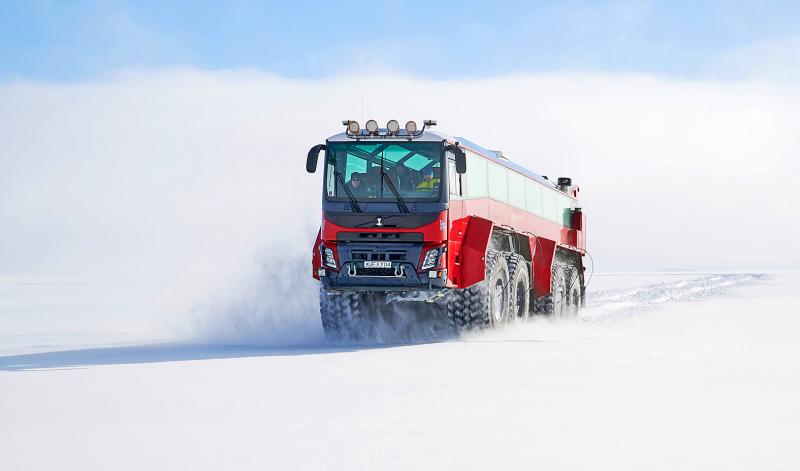Instead of a slow slog on snowshoes, a giant bus sweeps passengers at up to 60kph across Iceland’s second-largest glacier.
The red vehicle is 15m long and fitted with massive tires for traction across the powder snow of western Iceland’s vast Langjokull ice cap.
From its highest point, at about 1,450m, the spectacular view takes in other snow-covered peaks.

Photo: AFP
With its 850 horsepower engine, the tour bus — resembling something out of a science-fiction movie — smoothly traverses the icy terrain on eight wheels, each 2m in diameter.
It has been named “Sleipnir” after the mythical eight-legged horse ridden by the Norse god Odin.
As strong winds whip up the fresh snow, the bus — created by keen mechanic Astvaldur Oskarsson, 59, who runs a specialized storage company — climbs higher to emerge from the low cloud into bright blue skies.
An Italian couple are among the few travelers to have braved the double COVID-19 test and five-day quarantine required on arrival in Iceland.
“It feels really emotional. Touching something that is so old, you feel so in contact with the Earth,” Italian Rossella Greco, 30, told reporters of the tour, which costs 10,000 Icelandic krona (US$71).
The bus’ dimensions allow it to cross crevasses 3m wide, although also mean it guzzles 45l of petrol per kilometer and leaves deep tracks in the snow.
However, the impact on the glacier “is small, as long as it is just one or two vehicles,” Icelandic Meteorological Office glaciologist Thorsteinn Thorsteinsson said.
Along the path climbing from the foot of Langjokull, signs have been erected showing the ice line of every 20 years since 1940.
Nearly 250km2 of surface area has evaporated since 1890.
“The elevation of the glacier is getting lower in many, many places,” tour guide Gunnar Gudjonsson told reporters. “So it’s actually new mountains or new nunataks [the ridge or summit of a mountain protruding from an ice field] coming out of the glaciers.”
“It’s incredible how fast it is melting,” he said.
In August, the dam of a glacial lake, formed by melt water, broke, causing flooding.
“It was not a major event, but it happened in a region where we are not used to such phenomena,” Thorsteinsson said.
Powerful floods called jokulhaup are normal around Vatnajokull, the biggest glacier in Iceland and also in Europe.
However, these are generally due to volcanic activity.
Langjokull’s chances of survival are slim, Thorsteinsson said.
“If this continues in a similar way or even in a still warmer climate, then it’s very likely that all of Langjokull, or maybe 80 to 90 percent of it, will be gone by the end of this century,” he said.

‘IN A DIFFERENT PLACE’: The envoy first visited Shanghai, where he attended a Chinese basketball playoff match, and is to meet top officials in Beijing tomorrow US Secretary of State Antony Blinken yesterday arrived in China on his second visit in a year as the US ramps up pressure on its rival over its support for Russia while also seeking to manage tensions with Beijing. The US diplomat tomorrow is to meet China’s top brass in Beijing, where he is also expected to plead for restraint as Taiwan inaugurates president-elect William Lai (賴清德), and to raise US concerns on Chinese trade practices. However, Blinken is also seeking to stabilize ties, with tensions between the world’s two largest economies easing since his previous visit in June last year. At the
Nearly half of China’s major cities are suffering “moderate to severe” levels of subsidence, putting millions of people at risk of flooding, especially as sea levels rise, according to a study of nationwide satellite data released yesterday. The authors of the paper, published by the journal Science, found that 45 percent of China’s urban land was sinking faster than 3mm per year, with 16 percent at more than 10mm per year, driven not only by declining water tables, but also the sheer weight of the built environment. With China’s urban population already in excess of 900 million people, “even a small portion

UNSETTLING IMAGES: The scene took place in front of TV crews covering the Trump trial, with a CNN anchor calling it an ‘emotional and unbelievably disturbing moment’ A man who doused himself in an accelerant and set himself on fire outside the courthouse where former US president Donald Trump is on trial has died, police said yesterday. The New York City Police Department (NYPD) said the man was declared dead by staff at an area hospital. The man was in Collect Pond Park at about 1:30pm on Friday when he took out pamphlets espousing conspiracy theories, tossed them around, then doused himself in an accelerant and set himself on fire, officials and witnesses said. A large number of police officers were nearby when it happened. Some officers and bystanders rushed

Beijing is continuing to commit genocide and crimes against humanity against Uyghurs and other Muslim minorities in its western Xinjiang province, U.S. Secretary of State Antony Blinken said in a report published on Monday, ahead of his planned visit to China this week. The State Department’s annual human rights report, which documents abuses recorded all over the world during the previous calendar year, repeated language from previous years on the treatment of Muslims in Xinjiang, but the publication raises the issue ahead of delicate talks, including on the war in Ukraine and global trade, between the top U.S. diplomat and Chinese